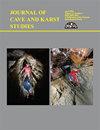利用高分辨率x射线计算机断层扫描测试石笋的制备用于古气候重建
IF 0.5
4区 地球科学
Q4 GEOSCIENCES, MULTIDISCIPLINARY
引用次数: 0
摘要
用于古气候分析的石笋通常应沿着中央生长轴被铺成石板。这是重要的第一步,因为它允许以最小的生长层的过采样或欠采样的最高分辨率采样。此外,沿中央生长轴的稳定同位素比率和微量元素浓度最接近地记录了气候变率。仅根据外部形貌来选择如何使中心生长轴最佳暴露以进行地球化学取样是具有挑战性的。高分辨率x射线计算机断层扫描(XRCT)可以提供无损、廉价和快速地识别石笋内部生长形态的能力。这些数据可以为选择最佳的板料平面提供信息,并可以帮助确定初步u系列定年的位置。我们开发了一个概念性筛选模型来快速评估未切割石笋的内部形态。通过XRCT扫描筛选内部形态的具体内容包括调查样品的内部孔隙度,空隙和间隙的数量和大小,生长层和生长轴的存在和不存在。我们证明了XRCT扫描可以捕捉到简单和复杂内部形态的未切割石笋生长中心的迁移。XRCT扫描有助于对具有复杂内部生长带的石笋进行研究,为在没有内部形态较简单的石笋时研究此类样品开辟了途径。此外,利用XRCT筛选石笋进行古气候重建,可以帮助研究人员选择哪些石笋应该在不破坏石笋的情况下返回洞穴,从而最大限度地减少对洞穴的影响,从而提高洞穴科学的可持续性。本文章由计算机程序翻译,如有差异,请以英文原文为准。
Using High-Resolution X-Ray Computed Tomography to Test the Preparation of Stalagmites for Paleo-Climate Reconstruction
Stalagmites being prepared for paleoclimate analysis should typically be slabbed along the central growth axis. This is an important first step because it allows for the highest resolution of sampling with minimal over- or under-sampling of the growth layers. Further, stable isotope ratios and trace element concentrations along the central growth axis most closely record climate variability. Choosing how to slab to best expose the central growth axis for geochemical sampling is challenging based on external morphology alone. High-resolution X-ray computed tomography (XRCT) can provide the ability to discern the internal growth morphology of stalagmites non-destructively, inexpensively, and rapidly. These data can inform selection of optimal slabbing plane(s) and can help identify locations for preliminary U-series dating. We develop a conceptual screening model to assess rapidly the internal morphologies of uncut stalagmites. The specifics of screening the internal morphologies through XRCT scans include investigating the internal porosity of the sample, the number and size of voids and hiatuses, and the presence and absence of growth layers and growth axes. We demonstrate that XRCT scans capture the migration of center of growth in uncut stalagmites of both simple and complex internal morphologies. XRCT scanning facilitates the investigation of stalagmites with complex internal growth banding, opening up avenues to work on such samples when stalagmites with simpler internal morphologies are not available. Further, screening stalagmites for paleoclimate reconstructions using XRCT improves the sustainability of speleothem science by helping researchers select which stalagmites should be returned to caves without destructive slabbing, thereby minimizing impact on caves.
求助全文
通过发布文献求助,成功后即可免费获取论文全文。
去求助
来源期刊

Journal of Cave and Karst Studies
地学-地球科学综合
CiteScore
1.90
自引率
0.00%
发文量
6
审稿时长
>12 weeks
期刊介绍:
The Journal of Cave and Karst Studies is a multidisciplinary journal devoted to cave and karst research. The Journal is seeking original, unpublished manuscripts concerning the scientific study of caves or other karst features. Authors do not need to be members of the National Speleological Society, but preference is given to manuscripts of importance to North American speleology.
 求助内容:
求助内容: 应助结果提醒方式:
应助结果提醒方式:


